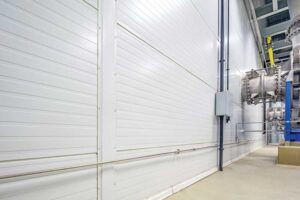Deep Freeze
by Brooke Smith | 1 May 2024 1:00 pm

In the construction of cold storage facilities, insulation designed to help preserve perishable goods such as produce, frozen foods, pharmaceuticals, and other temperature-sensitive products has changed a lot over the years. Many different materials have been used in these facilities to keep cold air in and hot air out.
Before the invention of the automobile, horsehair was initially used in these applications. From there, foam glass dipped in hot tar, wood construction, and cork were used to insulate these buildings through the 1950s. By the 1960s, the industry turned to hybrid foam glass panels that were produced with a thin aluminum face on both sides. Over the next few decades, the industry used beadboard expanded polystyrene (EPS) panels with redwood splines to bridge the joint before going to extruded polystyrene (XPS) panels with redwood support splines. Modern-day insulated metal panels (IMPs) evolved from there, initially starting with polyurethane (PUR) cores, then evolving to polyisocyanurate (PIR) cores. Most recently, the industry has seen the innovation of a self-blended PIR hybrid insulation core from at least one manufacturer. This is one of the most thermally efficient insulation cores on the market today.
The history of insulation shows technology has made headway, evolving to the thermally efficient IMPs of today that feature foam insulation cores and high R-values to ensure the highest insulation reliability for temperature-controlled environments.
The superior insulating properties of today’s IMPs are driving high demand for this building envelope solution as the construction of cold storage facilities increases. According to Maximize Market Research, the cold storage construction market size, valued at $12.54 billion in 2022, is expected to grow by 14 percent from 2023 to 2029, reaching nearly $31.37 billion.1
Advanced IMP technology provides a wide range of benefits that make these panels the ideal building envelope solution for cold storage facilities.
High performance
The superior thermal performance of IMPs is key to keeping products safe in cold storage facilities. An all-in-one system with a core of continuous, rigid insulation and airtight and weathertight IMPs reduces the thermal bridging that is typical of many other wall systems. IMPs deliver the high R-values needed to ensure a stable interior environment, keeping temperature-sensitive goods at the right temperature as they await distribution.
Energy efficiency
Cold storage facilities consume a lot of energy with operating temperatures that can range from 7 to 18 C (20 to 65 F).
IMPs minimize heat transfer between the interior and exterior environments and deliver long-term air and weather tightness, helping to reduce the amount of energy required to keep cold storage buildings at temperature. That energy efficiency translates to lower operating costs and fewer greenhouse gas emissions while maintaining a stable low temperature environment that protects stored products.
Easy installation
IMPs are a fixture in the construction of cold storage facilities because they provide a high-performance, low-energy, weathertight building envelope in a fraction of the time of traditional site-built wall and roof enclosure systems.
Requiring only one type of installer rather than multiple trades, these lightweight, modular panels allow a building to be quickly dried-in, helping construction projects stay on track, resulting in reduced downtime and on-time project completion.
Durability
Durable in design and low maintenance, IMPs are ideal for the construction of cold storage facilities. These panels last for decades with minimal maintenance and upkeep, and they can stand up to harsh weather while maintaining their air and water tightness.
Cold storage IMPs are offered in smooth surfaces that can be finished with a coating accepted by the U.S. Department of Agriculture. Easy to clean, these panels can withstand the heavy sanitization that is found in cold storage facilities. Their tight-fitting interlocking joints resist moisture and lower the risk of toxic mold or bacterial growth.
Insulation has come a long way since the days of horsehair and foam glass dipped in hot tar. Today, advanced IMP technology delivers high thermal performance, energy efficiency, lower embodied carbon, ease of installation, and durability in the construction of cold storage facilities.
As the cold storage market continues to grow, demand for building envelope solutions like this are critical to protecting product safety and quality, while shrinking a facility’s carbon footprint, cutting energy usage, and reducing maintenance costs.
Note
1 See maximizemarketresearch.com/market-report/global-cold-storage-construction-market/98666/
Karim Muri is vice-president of marketing services and strategy development for Kingspan Insulated Panels North America. Muri has led strategic marketing in the construction products market for nearly 20 years. His global experience includes leadership roles in Australia and the United States, working in both the residential and commercial building sectors.
Source URL: https://www.metalconstructionnews.com/articles/features/deep-freeze/